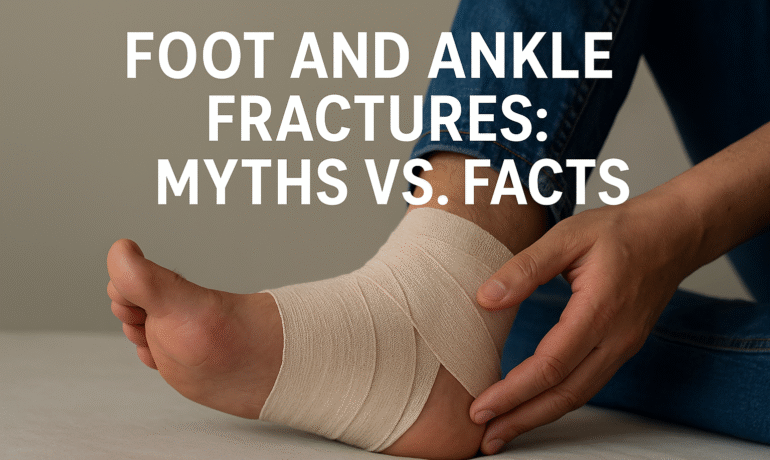Foot and ankle fractures are among the most common orthopedic injuries, affecting people of all ages. Whether caused by sports, accidents, or simple missteps, these injuries can impact mobility and quality of life. Unfortunately, several myths about foot and ankle fractures lead to delayed diagnosis and improper treatment. Let’s separate facts from fiction for better recovery and awareness.
Understanding Foot and Ankle Fractures
A foot fracture occurs when one or more of the 26 bones in the foot crack or break due to trauma, stress, or overuse. Similarly, an ankle fracture involves the breakage of bones forming the ankle joint — the tibia, fibula, or talus. Common causes include twisting injuries, falls, road accidents, and repetitive strain during sports. Early diagnosis through X-ray or MRI ensures accurate treatment and prevents long-term complications like joint stiffness and arthritis.
Myth 1: “If I Can Walk, My Foot Isn’t Broken.”
Fact: Many patients assume that if they can still walk, their bones are fine. In reality, mild to moderate ankle fractures or stress fractures may still allow partial weight-bearing. Ignoring symptoms like swelling, pain, or bruising can worsen the injury. It’s essential to get a clinical examination and imaging done even if walking seems possible.
Myth 2: “Swelling Will Go Away with Home Remedies.”
Fact: Ice packs and rest may provide temporary relief but won’t heal a fracture in the foot or ankle. Without proper medical evaluation, bone fragments may heal improperly, leading to chronic pain or deformity. Always consult an orthopedic specialist to determine if immobilization, casting, or surgery is required.
Myth 3: “All Fractures Need Surgery.”
Fact: Not every foot or ankle fracture requires surgery. Stable fractures often heal well with casting or bracing. Surgery is recommended only for displaced or complex fractures. Advanced techniques like minimally invasive fixation promote faster recovery with smaller scars and lower infection risk.
Myth 4: “Ankle Sprains and Fractures Are the Same.”
Fact: A sprain affects the ligaments, while a fracture involves bone injury. The symptoms may look similar—pain, swelling, and bruising—but the treatment differs significantly. Proper imaging helps distinguish between them. Treating a fracture as a sprain may lead to improper bone healing and long-term ankle instability.
Myth 5: “Once Healed, You’ll Never Have Problems Again.”
Fact: Even after healing, foot and ankle injuries may lead to stiffness, reduced mobility, or arthritis if not rehabilitated correctly. Physiotherapy and strengthening exercises are vital for restoring joint flexibility and preventing future injuries.
Signs and Symptoms You Should Never Ignore
Persistent pain or tenderness after an injury
Swelling and bruising that worsen with time
Inability to bear weight or move the foot properly
Deformity or misalignment of the ankle joint
Tingling or numbness in the toes
Ignoring these signs can result in delayed healing and long-term joint issues.
Diagnosis and Treatment Options
A fracture specialist performs physical assessments and imaging to identify the injury type. Depending on severity, treatment includes:
Immobilization: Plaster casts or walking boots to stabilize bones.
Medication: Pain relief and anti-inflammatory drugs.
Surgery: Used for displaced fractures using plates, screws, or rods.
Rehabilitation: Physiotherapy for regaining strength and balance.
Early intervention ensures better alignment, faster recovery, and improved outcomes.
Recovery Tips After a Foot or Ankle Fracture
Follow your doctor’s advice strictly.
Avoid putting weight on the injured leg until approved.
Perform physiotherapy exercises regularly.
Maintain a balanced diet rich in calcium and vitamin D.
Wear supportive footwear to prevent reinjury.
Conclusion
Foot and ankle fractures need timely diagnosis and care. Don’t let myths guide your recovery—consult an orthopedic expert to ensure proper healing and regain full mobility.

